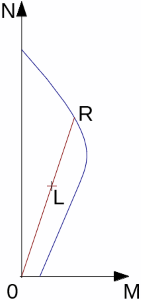Design of Longitudinal Reinforcement for Slabs
The design of reinforcement is performed for load caused by the bending moment Md. The program provides the required area of tensile and compressive (if needed) reinforcement. It takes into account conditions for the minimum and maximum degree of reinforcement in a given cross-section. First, the program determines the location of neutral axis as:

Providing the location of neutral axis is less than the allowable one (x < xmax), the program determines the area of tensile reinforcement Ast from the expression:
![]()
Providing the location of neutral axis is greater than the allowable one (x > xmax), the program determines the areas of both compressive Asc and tensile Ast reinforcement from the expressions:
![]()
![]()
![]()
The limit location of neutral axis is found from:
![]()
The computed degree of reinforcement is checked using the following expressions:
| ||
where: |
| |
| ||
| - for fy = 460 N/mm2 | |
| - for fy = 250 N/mm2 | |
If the maximum degree of reinforcement ρmax is exceeded, the program informs the user that the longitudinal reinforcement cannot be designed for a given cross-section.
The program verifies a reinforced concrete pile using the method of limit deformation. The maximum allowable strain of concrete in compression is 0,002 - 0,0035.
The degree of reinforcement is checked using the formula:
![]()
- Column - check for dominant compression
| ||
ρmax = 0,04 | ||
ρmin = 0,0013 | - for fy = 460 N/mm2 | |
ρmin = 0,0024 | - for fy = 250 N/mm2 | |
- Beam - check for dominant bending
| ||
ρmax = 0,06 | ||
ρmin = 0,004 | ||
where: | d | - | pile diameter |
As | - | reinforcement area |
 Interaction diagram N-M
Interaction diagram N-M
Usage ratio of concrete cross-section subject to the combination of bending moment and normal force is determined as |0L| / |0R|. Where L is load and R is strength with prescribed eccentricity.